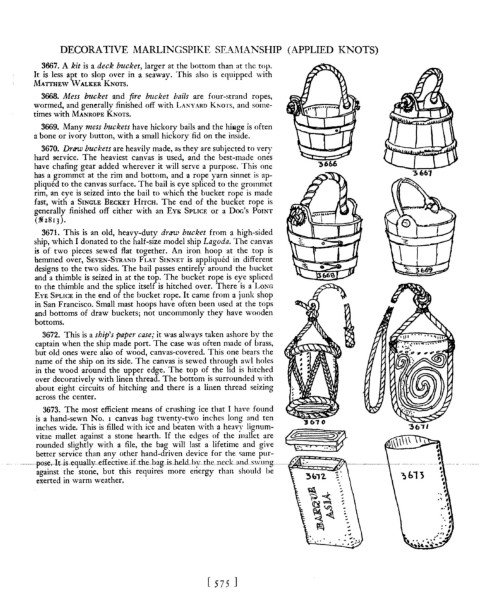Page 584 - The Ashley Book of Knots
P. 584
DECORATIVE MARLING SPIKE SEAJ\IANSHIP (APPLIED KNOTS)
3667. A kit is a deck bucket, larger at the bottom than ;Jt the top.
It is less apt to slop over in a seaway. This also is equipped with
MATIHEW WALKER KNOTS.
3668. Mess bucket and fire bucket bails are four-strand ropes,
wormed, and generally finished off with LANYARD KNOTS, and some-
times with MANROPE KNOTS.
3669. Many mess buckets have hickory bails and the hiilge is often
a bone or ivory button, with a small hickory fid on the inside.
3670. Draw buckets are heavily made, as they are subjected to very
hard service. The heaviest canvas is used, and the best-made ones
have chafing gear added wherever it will serve a purpose. This one
has a grommet at the rim and bottom, and a rope yarn sinnet is ap-
pliqued to the canvas surface. The bail is eye spliced to the grommet
rim, an eye is seized into the bail to which the bucket rope is made
fast, with a SINGLE BECKET HITCH. The end of the bucket rope is
generally finished off either with an En: SPLICE or a DOG's POINT
(~28IJ)· o
3671. This is an old, heavy-duty draw bucket from a high-sided
ship, which I donated to the half-size model ship Lagoda. The canvas
is of two pieces sewed flat together. An iron hoop at the top is
hemmed over, SEVEN-STRAND FLAT SINNET is appliqued in different
designs to the two sides. The bail passes entirely around the bucket
and a thimble is seized in at the top. The bucket rope is eye spliced
to the thimble and the splice itself is hitched over. There is a LONG
EYE SPLICE in the end of the bucket rope. It came from a junk shop
in San Francisco. Small mast hoops have often been used at the tops
and bottoms of draw buckets; not uncommonly they have wooden
bottoms.
3672. This is a ship's paper case; it was always taken ashore by the
captain when the ship made port. The case was often made of brass,
but old ones were allio of wood, canvas-covered. This one hears the
name of the ship on its side. The canvas is sewed through awl holes
in the wood around the upper edge. The top of the lid is hitched
over decoratively with linen thread. The bottom is surrounded with
about eight circuits of hitching and there is a linen thread seizing
across the center.
3673. The most efficient means of crushing ice that I have found
is a hand-sewn No. I canvas bag twenty-two inches long and ten
inches wide. This is filled with ice and beaten with a heavy lignum- 36"1'
vitae mallet against a stone hearth. If the edges of the mallet are
rounded slightly with a file, the bag will last a lifetime and give
better service than any other hand-driven device for the "arne pur-
•
. _ ... -- f-------- f--- ~-.. - ..... -.. ... -. -... - .....
-
-
.
against the stone, but this requires more energy than should be
3b12 • ~b"5
-
exerted in warm weather. -
-
-
- . ,
J
-
"
,
~
-
- •
•
-
-
-
•
-
• •
~ • •
,. .
. "
• • - -
• • •
[ 575 ]

